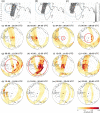Surface-to-space atmospheric waves from Hunga Tonga-Hunga Ha'apai eruption
- PMID: 35772670
- PMCID: PMC9492537
- DOI: 10.1038/s41586-022-05012-5
Surface-to-space atmospheric waves from Hunga Tonga-Hunga Ha'apai eruption
Abstract
The January 2022 Hunga Tonga-Hunga Ha'apai eruption was one of the most explosive volcanic events of the modern era1,2, producing a vertical plume that peaked more than 50 km above the Earth3. The initial explosion and subsequent plume triggered atmospheric waves that propagated around the world multiple times4. A global-scale wave response of this magnitude from a single source has not previously been observed. Here we show the details of this response, using a comprehensive set of satellite and ground-based observations to quantify it from surface to ionosphere. A broad spectrum of waves was triggered by the initial explosion, including Lamb waves5,6 propagating at phase speeds of 318.2 ± 6 m s-1 at surface level and between 308 ± 5 to 319 ± 4 m s-1 in the stratosphere, and gravity waves7 propagating at 238 ± 3 to 269 ± 3 m s-1 in the stratosphere. Gravity waves at sub-ionospheric heights have not previously been observed propagating at this speed or over the whole Earth from a single source8,9. Latent heat release from the plume remained the most significant individual gravity wave source worldwide for more than 12 h, producing circular wavefronts visible across the Pacific basin in satellite observations. A single source dominating such a large region is also unique in the observational record. The Hunga Tonga eruption represents a key natural experiment in how the atmosphere responds to a sudden point-source-driven state change, which will be of use for improving weather and climate models.
© 2022. The Author(s).
Conflict of interest statement
The authors declare no competing interests.
Figures













Comment in
-
Atmospheric waves reinforced tsunami after Tongan eruption.Nature. 2022 Sep;609(7928):677-678. doi: 10.1038/d41586-022-01855-0. Nature. 2022. PMID: 35941383 No abstract available.
References
-
- Poli, P. & Shapiro, N. M. Rapid characterization of large volcanic eruptions: measuring the impulse of the Hunga Tonga explosion from teleseismic waves. ESSOAr10.1002/essoar.10510358.1 (2022).
-
- Pyle, D. M. in The Encyclopedia of Volcanoes (eds Sigurdsson, H. et al.) 263–269 (Elsevier, 2000).
-
- Carr JL, Horvath A, Wu DL, Friberg MD. Stereo plume height and motion retrievals for the record-setting Hunga Tonga-Hunga Ha’apai eruption of 15 January 2022. Geophys. Res. Lett. 2022;49:e2022GL098131. doi: 10.1029/2022GL098131. - DOI
-
- Harrison G. Pressure anomalies from the January 2022 Hunga Tonga‐Hunga Ha’apai eruption. Weather. 2022;77:87–90. doi: 10.1002/wea.4170. - DOI
-
- Garrett CJR. Atmospheric edge waves. Q.J Royal Met. Soc. 1969;95:731–753. doi: 10.1002/qj.49709540607. - DOI
Publication types
Grants and funding
LinkOut - more resources
Full Text Sources

